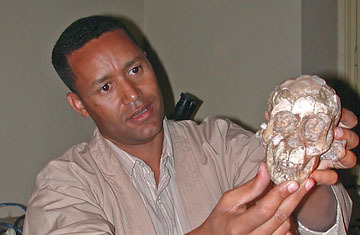
Above: Paleoanthropologist Zeresenay Alemseged, the man
who discovered Selam (also known us “Lucy’s Baby”), a 3
year old girl who died three million years ago in Ethiopia, is
featured in the following PBS Documentary.
PBS Program Description
First Steps: Six million years ago, what set our ancestors on the path from ape to human? Aired November 3, 2009 on PBS. Part 2 Premiers on air and online November 10, 2009.
Where did we come from? What makes us human? An explosion of recent discoveries sheds light on these questions, and NOVA’s comprehensive, three-part special, “Becoming Human,” examines what the latest scientific research reveals about our hominid relatives.
Part 1, First Steps, examines the factors that caused us to split from the other great apes. The program explores the fossil of “Selam,” also known as “Lucy’s Child.” Paleoanthropologist Zeray Alemseged spent five years carefully excavating the sandstone-embedded fossil. NOVA’s cameras are there to capture the unveiling of the face, spine, and shoulder blades of this 3.3 million-year-old fossil child. And NOVA takes viewers “inside the skull” to show how our ancestors’ brains had begun to change from those of the apes.
Why did leaps in human evolution take place? First Steps explores a provocative “big idea” that sharp swings of climate were a key factor.
The other programs in the Becoming Human series are Part 2: Birth of Humanity, which profiles the earliest species of humans, and Part 3: Last Human Standing, which examines why, of various human species that once shared the planet, only our kind remains.
Photo credit: Max Planck Institute for Evolutionary Anthropology
Related: Watch Zeresenay explain his dicovery


























gobez gobez
Jegna Jegna
All of us take the pride about the fact that Ethiopia as well as The East African Coast hold a respectable space in the search and chronology of The orders of Human physical Development.
All ordinary readers of Ethiopian Human,biological(flora and fauna)history-feel the gap as to the expansion of knowldge in non human fossil records.
References to fossils by Pliny the Elder Natural History xxxvii,167 and 8.77 about Ammonites,Catoblepas etc…,could be supplimentary topics for students of such an outstanding scientists as is currently presented by Tadias Magazine.
Hi Zeresenay,
I really appreciate your discovery. Moreover, I like your positive outlook to Africa.